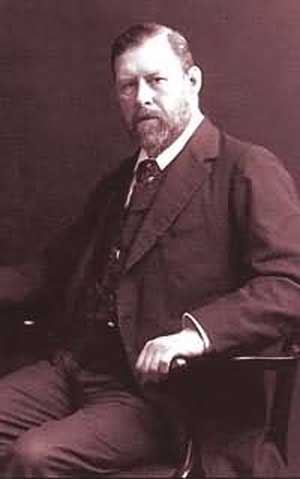The directory «Plots»
Stoker Bram
(1847—1912)

Abraham "Bram" Stoker was an Irish writer, best remembered as the author of the influential horror novel Dracula. In his honour, the Horror Writers Association recognizes "superior achievement" in horror writing with the Bram Stoker Award.
He was born in 1847 at 15 Marino Crescent – then as now called "The Crescent" – in Fairview, a coastal suburb of Dublin, Ireland. His parents were Abraham Stoker (born in 1799; married Stoker's mother in 1844; died on October 10, 1876) and the feminist Charlotte Mathilda Blake Thornely (born in 1818; died in 1901). Stoker was the third of seven children. Abraham and Charlotte were members of the Clontarf Church of Ireland parish and attended the parish church (St. John the Baptist located on Seafield Road West) with their children, who were both baptised there.
Stoker was an invalid until he started school at the age of seven — when he made a complete and astounding recovery. Of this time, Stoker wrote, "I was naturally thoughtful, and the leisure of long illness gave opportunity for many thoughts which were fruitful according to their kind in later years."
After his recovery, he became a normal young man, even excelling as an athlete (he was named University Athlete) at Trinity College, Dublin (1864–70), from which he graduated with honours in mathematics. He was auditor of the College Historical Society and president of the University Philosophical Society, where his first paper was on "Sensationalism in Fiction and Society".
In 1876, while employed as a civil servant in Dublin, Stoker wrote a non-fiction book (The Duties of Clerks of Petty Sessions in Ireland, published 1879) and theatre reviews for The Dublin Mail, a newspaper partly owned by fellow horror writer J. Sheridan Le Fanu. His interest in theatre led to a lifelong friendship with the English actor Henry Irving. He also wrote stories, and in 1872 "The Crystal Cup" was published by the London Society, followed by "The Chain of Destiny" in four parts in The Shamrock.
In 1878 Stoker married Florence Balcombe, a celebrated beauty whose former suitor was Oscar Wilde. The couple moved to London, where Stoker became business manager (at first as acting-manager) of Irving's Lyceum Theatre, a post he held for 27 years. The collaboration with Irving was very important for Stoker and through him he became involved in London's high society, where he met, among other notables, James McNeil Whistler, and Sir Arthur Conan Doyle. In the course of Irving's tours, Stoker got the chance to travel around the world.
The Stokers had one son, Irving Noel, who was born on December 31, 1879.
Bram Stoker died in 1912, and was cremated and his ashes placed in a display urn at Golders Green Crematorium. After Irving Noel Stoker's death in 1961, his ashes were added to that urn. The original plan had been to keep his parents' ashes together, but after Florence Stoker's death her ashes were scattered at the Gardens of Rest.
He supplemented his income by writing a large number of novels, his most famous being the vampire tale Dracula which he published in 1897. Before writing Dracula, Stoker spent eight years researching European folklore and stories of vampires. Dracula is an epistolary novel, written as collection of diary entries, telegrams, and letters from the characters, as well as fictional clippings from the Whitby and London newspapers. Stoker's inspiration for the story was a visit to Slains Castle near Aberdeen. The bleak spot provided an excellent backdrop for his creation.
Dracula has been the basis for countless films and plays. The first was Nosferatu directed by Friedrich Wilhelm Murnau and starring Max Schreck as Count Orlock. Nosferatu was produced while Florence Stoker, Bram Stoker's widow and literary executrix, was still alive. Represented by the attorneys of the British Incorporated Society of Authors, she eventually sued the filmmakers. Her chief legal complaint was that she had been neither asked for permission for the adaptation nor paid any royalty. The case dragged on for some years, with Mrs Stoker demanding the destruction of the negative and all prints of the film. The suit was finally resolved in the widow's favour in July 1925. Some copies of the film survived, however, and Nosferatu is now widely regarded as an innovative classic. The most famous film version of Dracula is the 1931 production starring Bela Lugosi and which spawned several sequels that had little to do with Stoker's novel.
Chad, 1998, Dracula
Chad, 1998, Bela Lugosi as Dracula
Chad, 1998, Bela Lugosi as Dracula
Great Britain, 1997, Dracula
Great Britain, 2008, Dracula
Guinea, 2008, Dracula, Brem Stoker
Guinea, 2008, «Dracula»
Irland, 1997, Dracula and Bat
Irland, 1997, Dracula with victim
Irland, 1997, Dracula emerging from coffin
Irland, 1997, Dracula and Wolf
Irland, 2012, Bram Stoker. Count Dracula
Rumania, 1959, Prince Vlad Tepes
Rumania, 1959, Prince Vlad Tepes
Rumania, 1976, Prince Vlad Tepes
Rumania, 1997, Prince Vlad Tepes
Rumania, 1997, Dracula
Rumania, 2004, Bram Stoker and Dracula
Rumania, 2007, Prince Vlad Tepes and Principal Court
Sierra Leone, 1997, Bela Lugosi as Dracula
Singapore, 2009, «House of Dracula»
USA, 1997, Bela Lugosi as Dracula
Great Britain, 1997.05.13,  Bradford. Drakula
Bradford. Drakula
Great Britain, 1997.05.13,  Whitsby. Dracula Xociety
Whitsby. Dracula Xociety
Great Britain, 2008.06.10,  Swain's Lane, Highgate, London N6. Bat
Swain's Lane, Highgate, London N6. Bat
Irland, 2012.04.19,  Dublin. Castle of Dracula
Dublin. Castle of Dracula
Rumania, 1997.05.05,  Bucharest. Dracula
Bucharest. Dracula
Rumania, 2004.05.21,  Bistrita. Castle of Dracula
Bistrita. Castle of Dracula
Rumania, 1959,  Vlad Tepes
Vlad Tepes
Rumania, 1976,  Vlad Tepes
Vlad Tepes
Rumania, 1997,  Dracula
Dracula
Rumania, 1997,  Vlad Tepes
Vlad Tepes
Rumania, 2005,  Dracula
Dracula
Rumania, 2009,  Prince Vlad Tepes
Prince Vlad Tepes
Rumania, 1998,  Prince Vlad Tepes
Prince Vlad Tepes
Rumania, 1999,  Vlad Tepes
Vlad Tepes
USA, 1997,  Bela Lugosi as Dracula
Bela Lugosi as Dracula